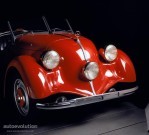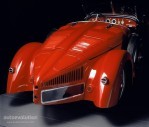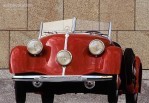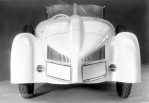Segment: Roadster & Convertible
Production years: 1934, 1935, 1936
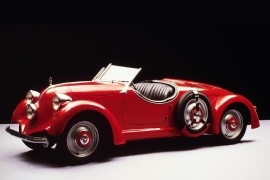 12 Photos
12 PhotosIn the late '20s, new ideas emerged for automotive design. Three of them were more important than the others: independent rear suspension, mid-engine cars, and streamlined bodies.
The 150 (W30) was developed as a sport-coupe for racing. But the standard names for that era was "sports saloon". Its closed body was somehow weird looking for the era, with two headlights and one, middle, projector. The sloped rear end had a special purpose: it hosted the engine. Unlike other cars from its era, the 150 used a mid-engine concept, with the engine and transmission fore and aft of the rear axle, respectively.
The engine was based on a 1.3-liter air-cooled unit, but with an increased displacement up to 1.5-liter. It delivered 55 hp, which was a lot for that era. To gain that output, a double-barrel carburetor was installed and it had overhead camshafts. All of these technological updates paid-off when the 150 sports saloon won four gold medals at the 2000-kilometer (1200 miles) endurance race across Germany in July 1934. The greatest sports saloon's triumph was achieved at the end of 1934 when it led the race between Rome and Pisa on the famous Liege-Rome-Liege Rally.
At the end of 1934, the competition vehicle served as the basis for developing the 150 sports roadster (W 130), but the atypical styling for a Mercedes-Benz vehicle did not make it into production.
MERCEDES BENZ Typ 150 Sport Roadster (W30) 1934, 1935, 1936
- 150
MERCEDES BENZ Typ 150 Sport Roadster (W30)
150
ENGINE SPECS - 150 | |
|---|---|
| Cylinders: | L4 |
| Displacement: | 1498 cm3 |
| Power: | 40 KW @ 4600 RPM 55 HP @ 4600 RPM 54 BHP @ 4600 RPM |
| Fuel System: | Carburetor |
| Fuel: | Gasoline |
PERFORMANCE SPECS | |
|---|---|
| Top Speed: | 78 mph (126 km/h) |
TRANSMISSION SPECS | |
|---|---|
| Drive Type: | Rear Wheel Drive |
| Gearbox: | Manual, 3 Speed |
BRAKES SPECS | |
|---|---|
| Front: | Drums |
| Rear: | Drums |
TIRES SPECS | |
|---|---|
| Tire Size: | 5.00-17 |
DIMENSIONS | |
|---|---|
| Length: | 165.4 in (4201 mm) |
| Width: | 63 in (1600 mm) |
| Height: | 54.3 in (1379 mm) |
| Front/rear Track: | 51.2/50 in (1,300/1,270 mm) |
| Wheelbase: | 102.4 in (2601 mm) |
WEIGHT SPECS | |
|---|---|
| Unladen Weight: | 2160 lbs (980 kg) |
| Gross Weight Limit: | 2910 lbs (1320 kg) |
FUEL ECONOMY (NEDC) | |
|---|---|
| Combined: | 15.7 mpg US (15 L/100Km) |
| CO2 Emissions: | 356 g/km |


